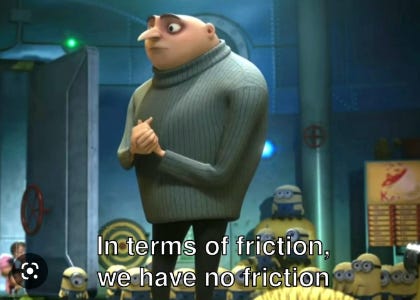The 3 types of user friction
Are you solving for the unobvious layers of friction?
Every great product manager or designer already knows how important it is to reduce friction from user journeys. But most times, teams only solve for the first layer of friction - associated with the UI and visual components 👀.
In his essay, Sachin Rekhi, founder and CEO at Notejoy, details the hierarchy of user friction. There are 2 layers above the base layer 🔺, which largely go unsolved.
Today, we’ll deep dive into what each type of friction is and look at specific examples from products that have significantly reduced these 3 types of friction.
Interaction Friction
The friction experienced by a user when interacting with your product’s interface. This relates to UI aspects that hinder your users 🧗♀️ from accomplishing their goal. Imagine Google autocomplete whenever you make a search. Google reduces the work you have to do by predicting your search.
Other common examples include reducing steps in a form field to the bare minimum needed and having a prominent call-to-action 📞 so users are clear on the next step they should take.
The recent wave of buy-now-pay-later companies have significantly reduced interaction friction associated with payments by making checkout a 1-click process.
Cognitive Friction
Cognitive friction is directly proportional to the mental effort 🧠 being used to complete a task.
Consider the task of notetaking. Before apps like Evernote, Notion and the like, there was significant cognitive load in regards to making notes. You were worried 😩 about always having your notepad handy, there was an underlying concern about losing or damaging your notes, and you couldn’t make significant changes to previous notes.
Digital notetaking 📝 removes this entire bucket of cognitive friction by making your notes always accessible, stored on the cloud so there’s no concern about damage, and ofcourse, easily editable so you can update notes as you gain more knowledge.
Another great example of reducing cognitive friction is a baby monitor 👩🍼. It is a device which allows you to hear or monitor your baby, when you are not around him/her. A baby monitor can offer audio or video data of your infant. These devices can also track breathing, temperature, and heart rate of the infant to provide you a more thorough picture of your baby’s health.
This significantly reduces the cognitive load a parent 👩👦 would feel when away from their child, worried about how their baby is doing. Now, they get direct line of contact to keep track of their baby.
Emotional Friction
Perhaps the deepest level of friction, emotional friction 🥶 refers to emotions your users feel that prevent them from accomplishing their goals. These are often the most difficult to understand and hence also the most difficult to address.
When we discussed the rise of BeReal, we noted that one of the reasons BeReal has exploded in popularity is because of the extremely low emotional bar to share a photo.
While you can have over 1,000 followers on Instagram, you’d probably only have 20 friends on BeReal, and you’d be happy with that. While some people might be hesitant to share themselves sleep-deprived 🥱 with thousands of vague acquaintances on Instagram, it’s much easier to share with your closest friends on BeReal.
Another example is the async video 🎥 communication platform, Loom. Loom’s goal is to make communicating at work simpler, reducing meetings where possible. But a lot of its users face camera shyness.
Rather than focus on what I had to share, I got distracted by the process of videotaping the message. How do I make eye contact? Is this awkward? Why don’t I like the way my face looks? 😩 Sometimes, I would end up recording Looms multiple times to get the right take. I didn't know how to not be awkward on camera. - Paulius Dragunas, Senior Engineering Manager at Loom
Loom combats this emotional friction by designing the app to focus not on the person recording the video (you are a small bubble on the corner of the screen), but rather maintaining focus on the task at hand.
And that’s it! Next time you design a flow, or revamp your product experience, keep in mind that you need to solve for more than just interaction friction 😁.
That’s it for this Spotlight. Thanks for joining us!
And while you’re here, remember, there are only 3 rules to life:
Be kind to everyone you meet
Don’t take yourself too seriously
Drink lots of water
See you next week!







